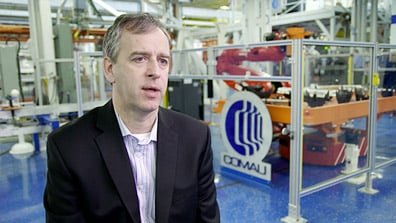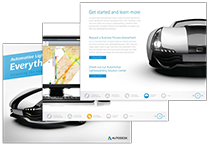Keyboard ALT + g to toggle grid overlay
Automotive lightweighting
Meeting the demands for more fuel efficient vehicles
Simulation for automotive lightweighting
Government regulations (CAFE) and consumer demand for vehicles with increased fuel economy are accelerating. With different options available to achieve fuel economy targets, automotive lightweighting is emerging as a clear favourite.

While physical prototyping and testing can be costly and time-consuming while returning limited results, Simulation allows you to fully explore different lightweighting opportunities within automotive designs
Automotive lightweighting simulation in action
Explore specific lightweighting examples by clicking the nodes on the vehicle and view the associated simulation results.
Hood
|
OBJECTIVE |
Predict / Validate |
|
PROCESS |
Using data from a draping simulation, as-manufactured material properties were extracted and analysed. Fibre orientations were determined and the structural integrity of the part was verified to determine that it met the functional specifications. |
|
BENEFITS |
|
|
TYPE |
100% carbon fibre |
Front fascia
|
OBJECTIVE |
Optimise |
|
PROCESS |
Using flexible cloud solving, hundreds of different materials and design iteration scenarios were tested to obtain the combination which yielded the lowest piece-part-cost and weight without taxing local computing resources. |
|
BENEFITS |
|
|
TYPE |
100% plastic polymer |
Seat pans (2)
|
OBJECTIVE |
Validate |
|
PROCESS |
The manufacturing process was simulated and a warpage analysis was performed to ensure the quality of the final part and to validate the overmoulding process before any tooling investments were made. |
|
BENEFITS |
|
|
TYPE |
Overmolded composite blank |
Oil pan
|
OBJECTIVE |
Predict |
|
PROCESS |
Fibre orientations were simulated and manipulated to optimise the strength of the part. The as-manufactured material properties were extracted to complete structural, thermal and vibration analysis to ensure product performance. |
|
BENEFITS |
|
|
TYPE |
Fibre-reinforced plastic |
Valve Cover w/ Integrated
Oil Separator
|
OBJECTIVE |
Predict |
|
PROCESS |
Simulation was used during the design stage to make decisions based on the manufacturability, material and thermal analysis, resulting in multiple components being combined into a single, integrated plastic part. |
|
BENEFITS |
|
|
TYPE |
Assembly to a single plastic part |
Advanced materials
As vehicle designs and functional requirements become more advanced, so do the materials. New materials are being developed every day, with more than 100 different types and gradients of plastic used in the average vehicle. For added strength and stiffness, fibres are injected into plastic parts during the manufacturing process.
Composite materials offer significant reductions in mass without sacrificing function. Advanced materials can be grouped into four categories.
-

Advanced processes
-

Plastic resins
-

Short and long fibre materials
-

Continuous fibre composites
Controlling the orientation of reinforcing fibres during the manufacturing process affects the strength and resistance properties of the part. Capturing these “as-manufactured“ material properties is critical to performing accurate analysis.
Simulation
Advanced materials require simulation tools designed to address analysis requirements. These materials react differently to traditional materials, due to their construction. Autodesk offers products that can help you to address the simulation requirements for automotive lightweighting applications.
Optimise the manufacturing process
Reduce weight
Control part strength and stiffness
Predict performance in practice
Select the best material for your application
Discover issues early in the design process
Direct from the industry
Learn from executives at leading companies as they share insights about trends in automotive lightweighting, the benefits of using plastics and composite materials and the role of simulation.
-

DUPONT
Jeff Sternberg, Global Automotive Technology DirectorJeff talks about taking a holistic approach to lightweighting by collaborating early in the design process with material suppliers, OEMs, part producers and technology providers.
watch video -

TREXEL, INC
Steve Braig, President & CEOSteve gives an overview MuCell technology and how it's being used for lightweighting initiatives.
Watch video -

DOW AUTOMOTIVE SYSTEMS
Allan James, Composites Marketing ManagerAllan has spent the last 30 years working with DOW. He shares his insights on plastics and composite materials and the importance of simulation.
Watch video -

CELANESE
Jeff Helms, Global Automotive ManagerJeff discusses trends in lightweighting, plastics and composite materials, eliminating prototypes with simulation and the urgency to begin lightweighting efforts now.
Watch video -

COMAU
Martin Kinsella, Director of Advanced Materials & Process TechnologyMartin confirms the accelerating lightweighting trend from the perspective of Comau, a large automation company that frequently works at the assembly stage of the vehicle.
Watch video
Download the white paper
Automotive Lightweighting – Everything Counts
Unlocking the opportunities with simulation
Gain a deeper understanding of automotive lightweighting trends, plastic and composite materials and the role simulation plays.
Conduct a Business Process Assessment
Let our Autodesk team of experts help you to identify software tools that can accurately simulate as-manufactured material properties and advanced materials, such as composites, to achieve your lightweighting goals.
We'll help you to create specific plans to get more from the investment and tools you already have and identify gaps you need to fill to improve your design and manufacturing practices.
Simulation products
Autodesk simulation software can help you to create accurate simulations for your lightweighting projects.

Moldflow
Optimise and validate your injection moulding process.

Helius PFA
Improve accuracy, efficiency and convergence of non-linear FEA solutions of composite structures.

Helius Composite
Predict the behaviour of composite materials, laminates and simple structures.
 Gain a deeper understanding of automotive lightweighting trends, plastic and composite materials and the role simulation plays.
Gain a deeper understanding of automotive lightweighting trends, plastic and composite materials and the role simulation plays.